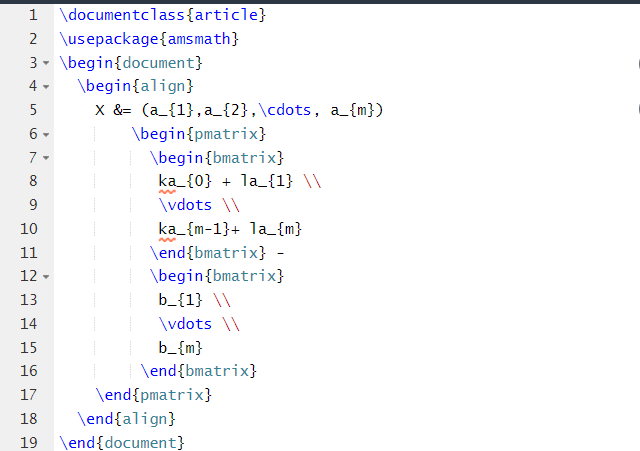Latex Vector Product

In the realm of linear algebra and vector calculus, the vector product, also known as the cross product, is a fundamental operation that combines two vectors in three-dimensional space to produce a new vector. This operation is widely used in physics, engineering, computer graphics, and other fields where understanding spatial relationships is crucial. Below, we delve into the definition, properties, and applications of the vector product, accompanied by LaTeX notation for clarity.
Definition of the Vector Product
Given two vectors (\mathbf{a} = \begin{pmatrix} a_1 \ a_2 \ a_3 \end{pmatrix}) and (\mathbf{b} = \begin{pmatrix} b_1 \ b_2 \ b_3 \end{pmatrix}) in (\mathbb{R}^3), their vector product (or cross product) is denoted as (\mathbf{a} \times \mathbf{b}) and is defined as:
[ \mathbf{a} \times \mathbf{b} = \begin{vmatrix} \mathbf{i} & \mathbf{j} & \mathbf{k} \ a_1 & a_2 & a_3 \ b_1 & b_2 & b_3 \ \end{vmatrix} = (a_2 b_3 - a_3 b_2)\mathbf{i} - (a_1 b_3 - a_3 b_1)\mathbf{j} + (a_1 b_2 - a_2 b_1)\mathbf{k} ]
where (\mathbf{i}), (\mathbf{j}), and (\mathbf{k}) are the standard unit vectors in the (x), (y), and (z) directions, respectively.
Properties of the Vector Product
The vector product has several important properties:
Anticommutativity:
(\mathbf{a} \times \mathbf{b} = -(\mathbf{b} \times \mathbf{a}))
This property highlights the non-commutative nature of the cross product.Linearity:
(\mathbf{a} \times (\mathbf{b} + \mathbf{c}) = \mathbf{a} \times \mathbf{b} + \mathbf{a} \times \mathbf{c})
The cross product distributes over vector addition.Zero Vector:
If (\mathbf{a} \times \mathbf{b} = \mathbf{0}), then (\mathbf{a}) and (\mathbf{b}) are parallel or one of them is the zero vector.Magnitude:
The magnitude of (\mathbf{a} \times \mathbf{b}) is given by:
[ |\mathbf{a} \times \mathbf{b}| = |\mathbf{a}| |\mathbf{b}| \sin \theta ]
where (\theta) is the angle between (\mathbf{a}) and (\mathbf{b}).
Geometric Interpretation
The vector product (\mathbf{a} \times \mathbf{b}) has a clear geometric meaning:
- Direction: The resulting vector is perpendicular to both (\mathbf{a}) and (\mathbf{b}), following the right-hand rule. If you curl the fingers of your right hand from (\mathbf{a}) to (\mathbf{b}), your thumb points in the direction of (\mathbf{a} \times \mathbf{b}).
- Magnitude: The magnitude represents the area of the parallelogram formed by (\mathbf{a}) and (\mathbf{b}).
Applications of the Vector Product
The vector product is essential in various fields:
Physics:
- Calculating torque ((\mathbf{\tau} = \mathbf{r} \times \mathbf{F})).
- Determining angular momentum ((\mathbf{L} = \mathbf{r} \times \mathbf{p})).
- Finding the normal vector to a plane.
- Calculating torque ((\mathbf{\tau} = \mathbf{r} \times \mathbf{F})).
Computer Graphics:
- Computing surface normals for lighting calculations.
- Determining the orientation of objects in 3D space.
- Computing surface normals for lighting calculations.
Engineering:
- Analyzing forces in three-dimensional structures.
- Solving problems involving rotations and moments.
- Analyzing forces in three-dimensional structures.
Example Calculation
Let (\mathbf{a} = \begin{pmatrix} 1 \ 2 \ 3 \end{pmatrix}) and (\mathbf{b} = \begin{pmatrix} 4 \ 5 \ 6 \end{pmatrix}). Compute (\mathbf{a} \times \mathbf{b}).
[ \mathbf{a} \times \mathbf{b} = \begin{vmatrix} \mathbf{i} & \mathbf{j} & \mathbf{k} \ 1 & 2 & 3 \ 4 & 5 & 6 \ \end{vmatrix} = (2 \cdot 6 - 3 \cdot 5)\mathbf{i} - (1 \cdot 6 - 3 \cdot 4)\mathbf{j} + (1 \cdot 5 - 2 \cdot 4)\mathbf{k} ]
[ = (-3)\mathbf{i} - (-6)\mathbf{j} + (-3)\mathbf{k} = \begin{pmatrix} -3 \ 6 \ -3 \end{pmatrix} ]
FAQ Section
What is the difference between the dot product and the cross product?
+The dot product yields a scalar and represents the projection of one vector onto another, while the cross product yields a vector perpendicular to both original vectors and represents their orientation in space.
Can the cross product be defined in 2D space?
+No, the cross product is only defined in 3D space. In 2D, you can compute a scalar result (the magnitude of the would-be cross product) using the determinant of a 2x2 matrix.
Why is the cross product anticommutative?
+The anticommutative property arises from the definition of the cross product, which involves the sine of the angle between vectors. Swapping the vectors changes the direction of the resulting vector.
How is the cross product used in computer graphics?
+In computer graphics, the cross product is used to compute surface normals for lighting, determine the orientation of 3D objects, and calculate rotations in animations.
Conclusion
The vector product is a powerful tool in linear algebra and vector calculus, offering a concise way to describe perpendicular relationships in three-dimensional space. Its applications span physics, engineering, and computer graphics, making it an indispensable concept for anyone working with vectors. By understanding its definition, properties, and geometric interpretation, you can leverage the vector product to solve complex problems with elegance and precision.


